The following was written by Brian.
I’m pretty sure this is my very first show report. Normally Chris or Tom give you the lowdown, but we’ve decided to give their tired angle a rest and offer a fresh, new perspective of one of our favorite shows from your favorite author – me!
As usual, the flight was uneventful and we landed on time, so off to our usual Airbnb we went. We love this place; affordable, large, clean and conveniently located about a mile from the Orange County Convention center – which is great because that place is enormous! We’re talking the second largest convention center in the US large. 7 million square feet of total space big. The main span of the Brooklyn Bridge could fit inside the West Building's contiguous exhibition space. Huge. You could fit 3.7 Rhode Islands inside it. Ok, I lied about that last part, but you get the picture. It’s really big. Bigger than Elaine’s really big salad. One more note of interest; this was the first time we attended a show and did not go out to dinner even once! A lot of deliveries and a lot of waiting, but these services are great and they pickup almost anything from almost anywhere nowadays.
On to the show!
As we try to do with every show, we arrived a day early to try to do some pre-show trading with other dealers (this is one of the ways we have of getting our fine collector base fresh inventory). However, due to (you know what is coming) Covid protocols, we were unable to meet in a rented space inside the convention center. That’s right, the OCCC would not rent us large rooms to conduct a little biz before the show. This was because of Covid, you see. You could go to the show the next 5 days and mingle/sneeze with/on strangers, not follow safe distancing practices and not wear a mask (yes, the overwhelming majority were not wearing masks and it was not enforced), but 25 or so of us couldn’t rent a large room for a few hours. Got it! Perfect sense!
Rant over.
The actual show, however, ranks up there with one of the better FUN shows for us. Not every dealer that we normally do biz with was there and that was kind of a bummer, but for the most part the usual suspects were in attendance, which is great for me! As the wholesale sales guy, my days are spent walking the floor showing our wares to as many dealers as possible. After two years of no FUN shows, I must admit it was really nice to see some old friendly faces. The sales were good, great even. Buyers were robustly buying and that’s always a good thing for our industry. Perhaps more importantly, we ourselves were able to buy a good amount – over 350 new pieces. The retail side was strong as well with strong attendance numbers.
With the show now over, we (most of us) packed up our belongings and new coins and headed to the airport, saying goodbye to warm sunny weather only to welcome the beautiful climes of New England in mid-January. The flight home was uneventful, although Tom and I were without Chris, as he decided it would be best to drive to Miami, sit in the rain and watch our Patriots lose in humiliating fashion.
Nice read, Brian!
And...350 new coins...!
Sorry your Patriots lost...
Hope to see more from you!
Pat and Mary Jo
The following was written by Brian.
Normally this would be called a ‘Part II’ follow up to the last blog about the fabulous Gold $4 Stella, but this time we’ll be discussing something far rarer – the 1879 Gold Twenty Dollar Stella.
While the Gold $4 Stella has enjoyed immense popularity over the years, it’s scarcer, much lesser known counterpart has slid under the numismatic radar for the most part.
Here she is, in all her glory. Just 1 of 5 known (1 of which is in the National Numismatic Collection in the Smithsonian) and commonly referred to among numismatists as the “Quintuple Stella”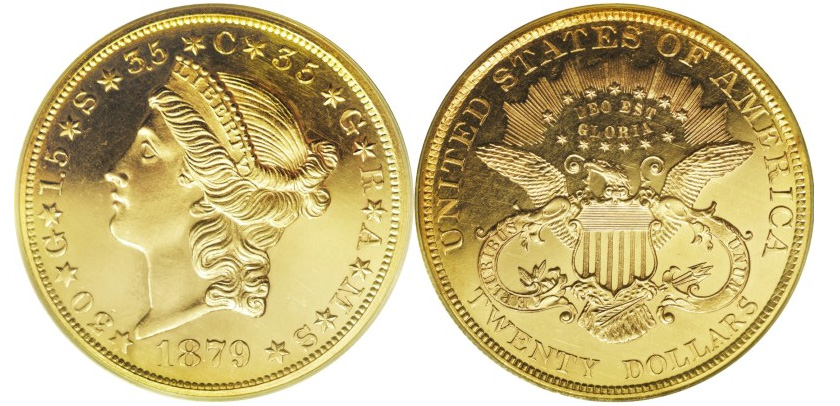
As with the $4 Stella, the Quintuple Stella is a proof-only pattern (Judd-1643). Also like the $4 Stella, it was meant to facilitate international trade and travel. There had been a schtickle of effort toward this goal earlier in the decade, specifically with the 1874 Bickford pattern $10 gold pieces, but 1879/1880 were the years that serious endeavors were made to accomplish these aims.
Here’s the Bickford example; an interesting design in its own right.
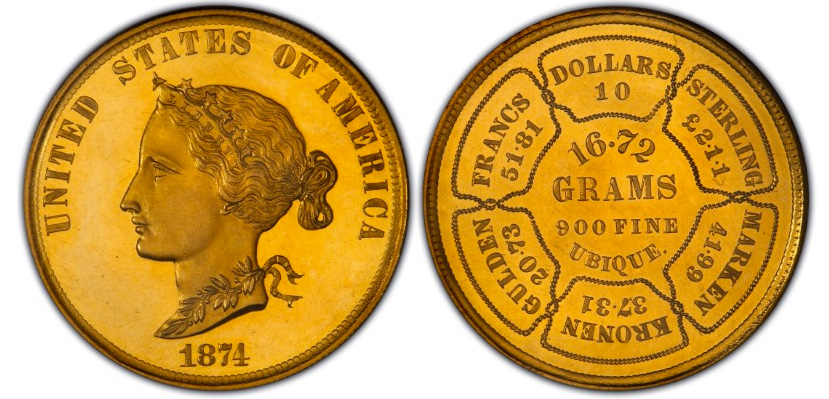
Like the other Stellas, the $20 Quintuple was designed by John Barton Longacre. Around the head is the legend +30+G+1.5+S+3.5+C+35+G+R+A+M+S+.
Fun facts: The last sale of a genuine $20 Gold Stella brought $1.88 million. The US Mint also produced other $20 Stella patterns including copper and gold plated examples.
Pretty cool!
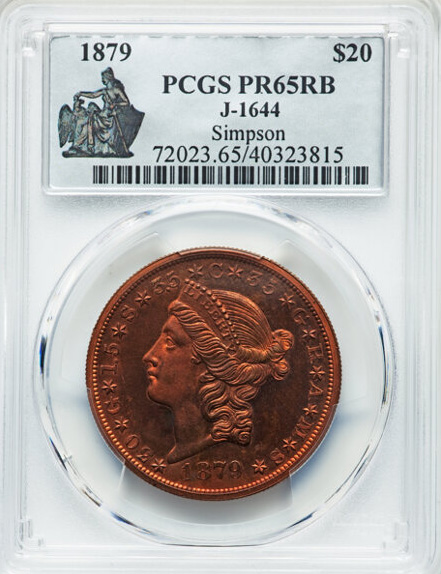
Thank you for sharing this amazing piece, very nice to know!
The following was written by Brian.
If you saw it, you never forgot it. Marlon Brandow’s legendary scream to his wife in the 1951 film A Streetcar Named Desire. So cool. Just so damned cool.
Almost as cool is another legend – this time in the field of numismatics; the 1879 and 1880 $4 Gold ‘Stella’.
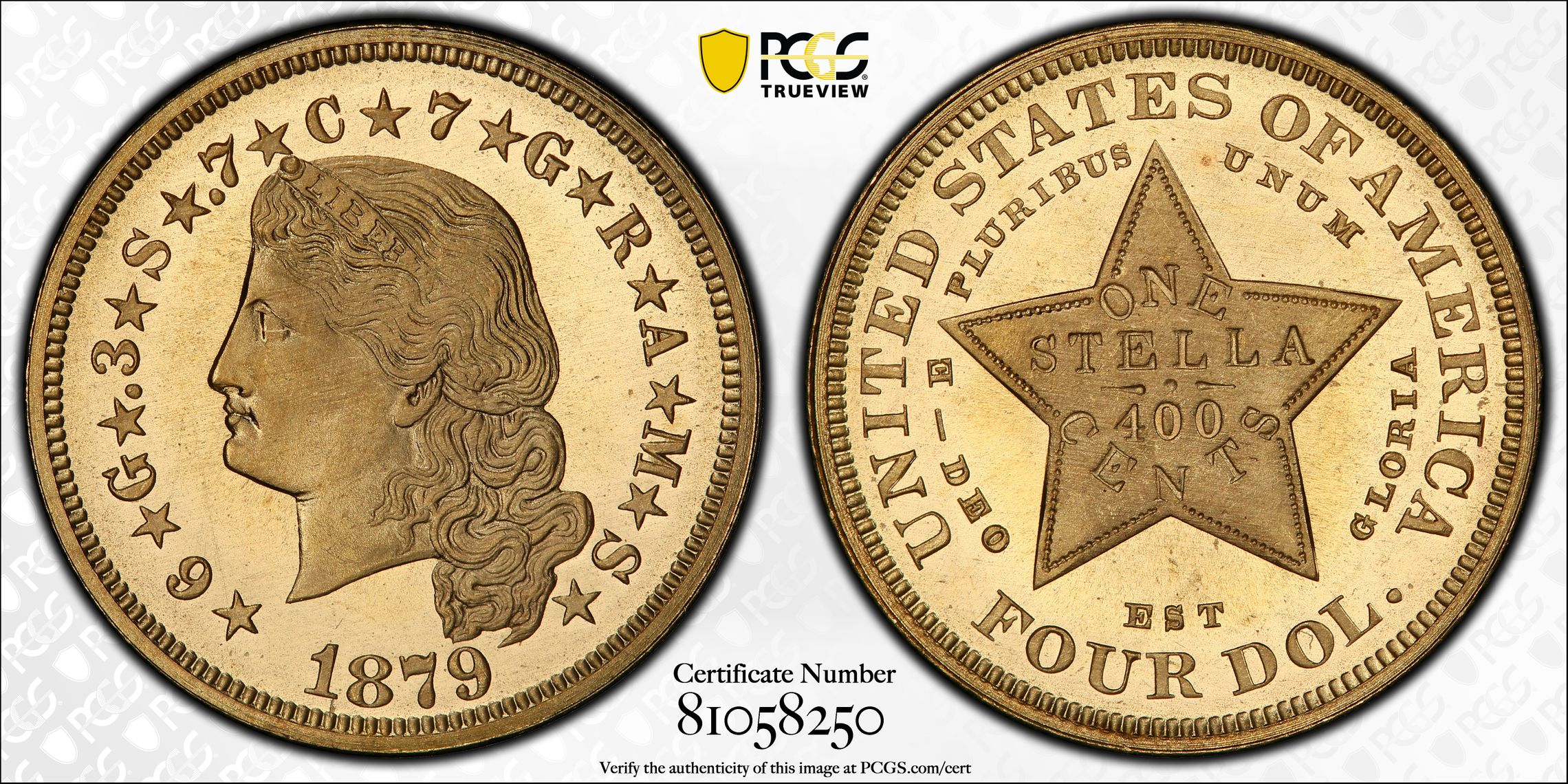
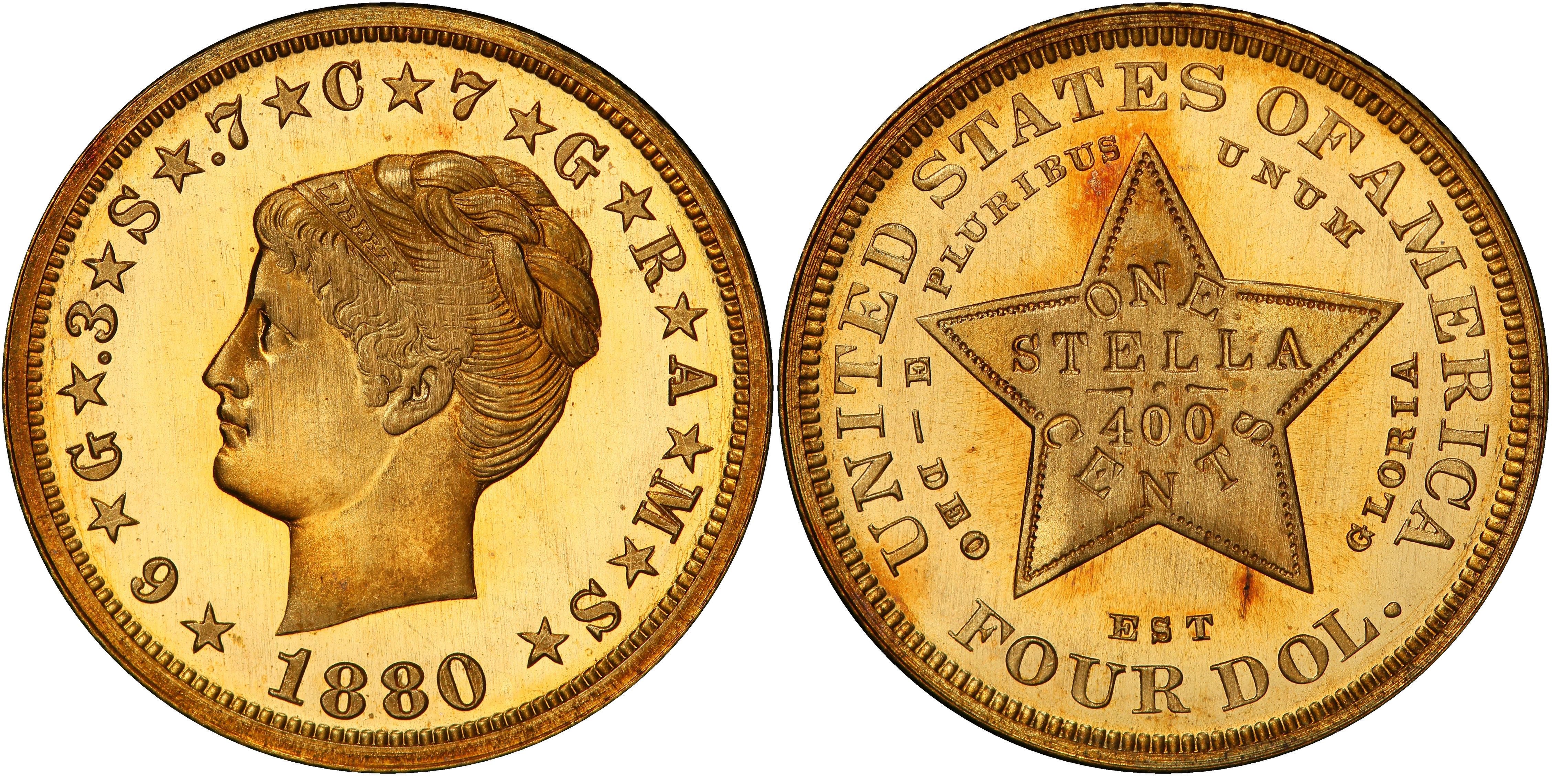
What a great issue and certainly a coin that you will find in every edition of the book 100 Greatest US Coins by Jeff Garrett (usually near the beginning of the book – top 20).
During the mid 1800’s, the United States had difficulties getting congressional approval for an international gold coin. Despite several attempts, nothing had moved forward until 1879 when the US Minister to Austria John Kasson (he was also the former Chairman of the Committee of Coinage, Weights, and Measures) suggested a US gold coin be created similar to the Austrian 8 Florin piece. The coin would have metallic content stated in metric units and would approximate in value the Spanish 20 pesetas, Dutch 8 florin, Austrian 8 florin, Italian 20 lire and the French 20 franc among others. The hopes of representing in metric units was that it would be easier for Europeans to use and it would aid in international trade and travel by US citizens. Its namesakes come from the Latin word for star “stella” and indeed the reverse bears a 5-pointed star.
Two US Mint chief engravers Charles Barber and John T. Morgan were responsible for the designs and the two portraits were very different from each other; Barber’s version displayed loose, fluid locks, while Morgan’s featured a tight, coiled, braided hair style. Each year – 1879 and 1880 - feature a flowing hair and coiled hair design amounting to 4 designs in total.
As mentioned, there are 4 known varieties, but the most readily available is the 1879 Flowing Hair Stella. This was a proof-only issue (as were the others) with a mintage of (about) 425 that were given to members of congress. It is said that many of the 1879 Flowing Hair Stellas were given to mistresses of these congressmen, which would explain the large number of ex-jewelry pieces. Now that’s a spicy coin-a! Although the 1879 Flowing Hair variety has the zesty back-story, the other 3 varieties are significantly rarer. The 1880 Coiled Hair has a mintage of just 20, but all 4 bring huge premiums at auction when and if they show up. A very tough, but most beloved and interesting US coin.
The following was written by Tom.
Around 20 years ago we started our current invoicing system, beginning at invoice number one. Today we reached a significant number; we created invoice number 100,000. It means little in the big picture other than to show that Northeast has been busy these past couple of decades. We are proud of our consistent daily activity and fair dealings of buying and selling with collectors, investors, and dealers, all while under the same ownership. We thank you, our customers, for making it all possible. We look forward to reaching the next big milestone!
Congratulations!
The following was written by Brian.
One of the most historic events in world currency came in the year 1497 with the creation of the Spanish ‘8 Reales’ silver coin. For many, many years after the first minting, these 8 Reales would be the standard of global currency. The 8 Reales was known as the Spanish Dollar but also was referred to as ‘pieces of eight’. At the time it was the largest denomination silver coin in the New World. The coin boasted a 38 mm diameter size.
For comparison, here is an 8 Reales next to a Morgan Dollar.
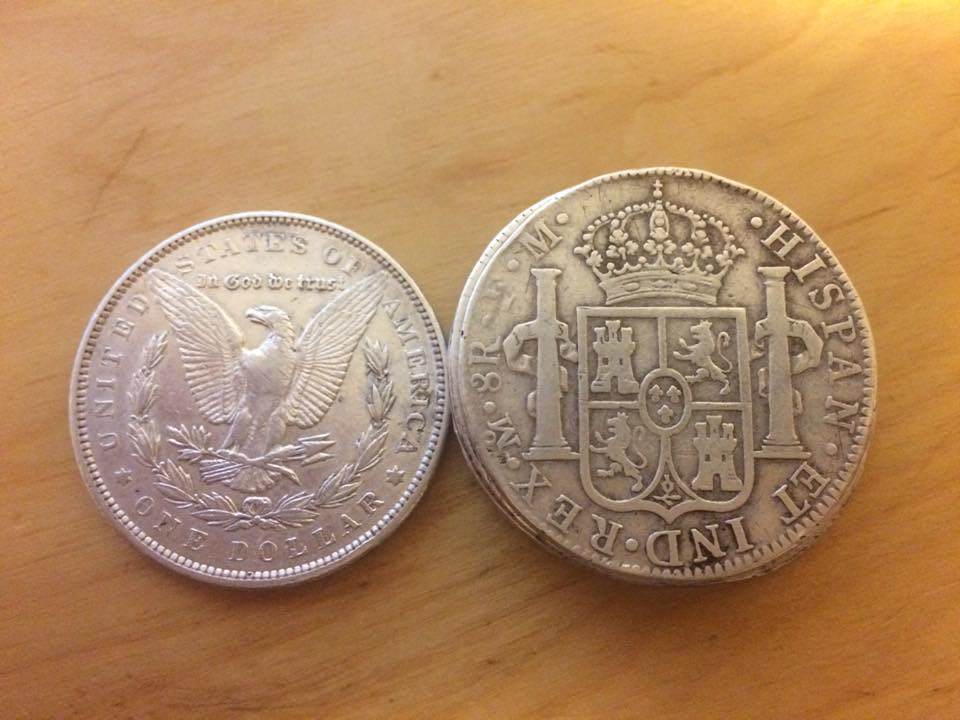
These coins were minted in Potosi, Bolivia where the main 'silver mountain' and mine were located. The harsh reality is that thousands of indigenous people were held as slaves to operate the mine. Many died due to the harsh conditions and the demand for silver to pay for Spain's military initiatives. This, however, did nothing to diminish the coins’ impact on world currency and one could say that it was the first uniformly used global currency.
The Spanish dollar coin was worth 8 reales (a unit of currency in Spain) and could be physically cut into 8 pieces or ‘bits’ to make change and indeed this was a very real practice. The Spanish Dollar could also be cut into quarters or even halves.
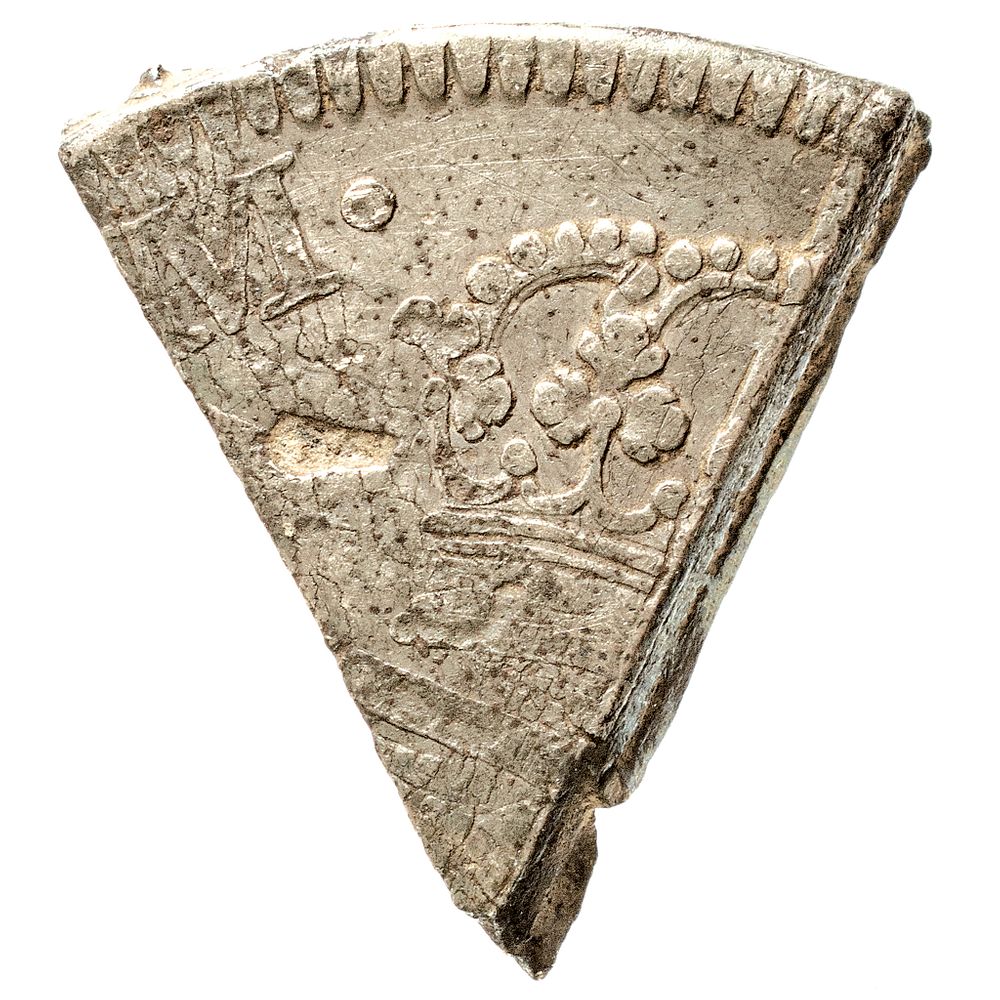

Here is a modern representation of how the bits might be cut.
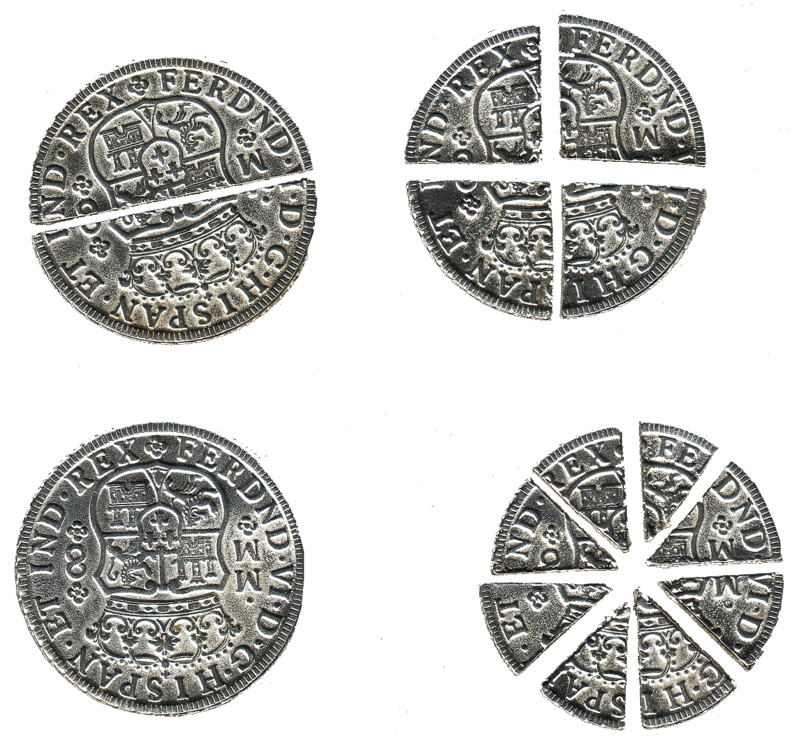
If you’re like me, you immediately think of a pie chart when viewing these bits. Here was my first thought and an example we can all wrap our heads around.
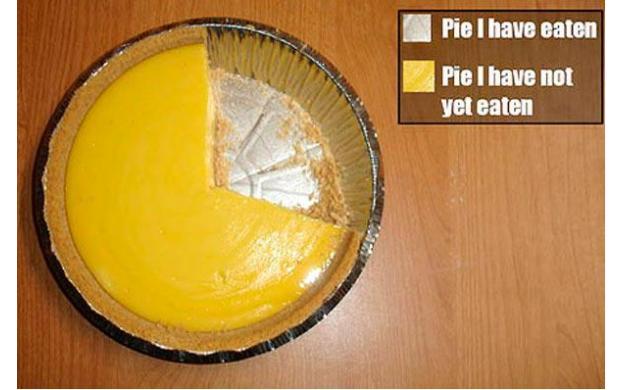
Spanish coins were increasingly popular and were preferred over other currency because they had a milled, or patterned edge, which prevented the practice of shaving down the edges of coins without being detected. Many years later, the United States and Mexico would adopt a similar style silver dollar/peso.
For this particular Spanish Mexican colony piece (below), the obverse has a profile portrait of King Charles IV and reads “Del Gratia 1805 Carolous IIII,” (Charles IIII by the Grace of God, 1805). The reverse shows an image of Spain’s Pillars of Hercules lesser royal coat of arms and reads, “HISPAN ET IND REX M 8R T H” (King of the Spains and the Indies, Mexico, 8 reales).

The ‘M’ is for Mexico, but more interestingly, the ‘T H’ on the reverse refers to the assayers initials; one for each of the first letters of the first names of the senior and junior assayer. In this case, the TH is for Thomás Butrón y Miranda & Henrique Buenaventura Azorín.
A great coin indeed and the popularity of this coin continues to this day. But hey, that’s just my two bits. The most important take from all of this is that you now know truly how much a shave and a haircut will cost you.




